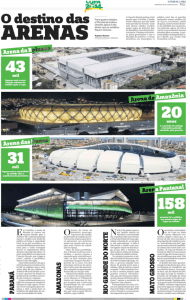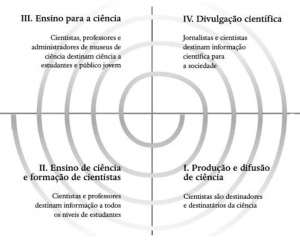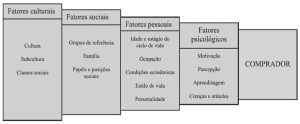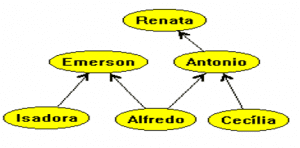INTERVIEW
LOPES, Maria Fernanda de Mello [1], PINHEIRO, Amálio [2]
LOPES, Maria Fernanda de Mello. PINHEIRO, Amálio. Transcriptions from a conversation with Ernesto Oroza. Revista Científica Multidisciplinar Núcleo do Conhecimento. Year 05, Ed. 11, Vol. 18, pp. 23-35. November 2020. ISSN: 2448-0959, Access link: https://www.nucleodoconhecimento.com.br/communication-en/with-ernesto-oroza
ABSTRACT
Interview with cuban artist and designer Ernesto Oroza. It is a conversation that took place in more than a moment and that, therefore, in the opinion, more than a transcription, requires the concept of transcreation, as developed by Haroldo de Campos, because it no longer consists only in an interview faithful to his first script, which was previously used in a way diverted from the planned. The conversation revolves around Oroza’s research: while commenting on his practice, the designer also paints a background on the Cuban context, discussing his tools, his methods of creation and research. The questions were related to some of his productions, especially the Project Technological Disobedience, exposed in 2015 at Caixa Cultural in Recife, a work that is thought here in relation to the idea of gambiarra (slang, in the sense of improvisation) in Brazil.
Keywords: Ernesto Oroza, technological disobedience, gambiarra, cultural processes.
INITIAL CONSIDERATIONS
Ernesto Oroza was born in Havana, Cuba, where he also developed his studies in graphic design and later in industrial design. He now lives in Saint-Étienne, France, where he works as head of the Graduate Department in Design and Research at the School of Art and Design in Saint-Étienne and as editorial director of Azimuts magazine; and is also curator of one of the central exhibitions of the upcoming Design Biennial of Saint-Étienne (BIDSE21). He was a visiting professor at Les Ateliers at the National Higher School of Industrial Creation in Paris, and professor at the Polytechnic Institute of Design in Havana. In his research, he launches looks and propositions that deal with reality in an unorthodox way, through themes related to architecture, interior design and objects. He has several published books, one of his last titles “Notes sur la maison moirée: (ou un urbanisme pour des villes qui se seer)” (2013). He has participated in several artistic residencies and received several awards, such as the World Space Creators Awards in Japan and the Guggenheim Fellowship in New York. He has participated in exhibitions in galleries and cultural centers around the world. In Brazil, Caixa Cultural in Recife exhibited its Technological Disobedience project in 2015.
This text, formatted much as a dialogue, since part of an interview proposal, is the result of some conversations between the researcher and the Cuban artist and designer Ernesto Oroza. The dialogues have always taken place electronically, in view of the social distancing required by COVID-19, as well as the geographical distance, given that Oroza spoke from Saint-Éttiene, In France, and the author, from São Paulo. As the contact occurred through various dialogues – between e-mails, videoconferences, meetings with the Research Group, in addition to the investigation of the interviewer – it seemed more appropriate to call this text “transcreation” (CAMPOS, 2015), instead of the simple transcription, of an interview. From a first conversation that, although scripted, did not happen in the planned way, other conversations were added together with more studies and reflections. The infidelity to the original script makes fruitful here the concept of Haroldo (“transcreation”), which in this proposal acts as a form of relationship in progress, and not as a closed application, and that takes place on several levels. First, by deviate from the traditional and faithful idea of interview; then, by the very translation of the language, since much of the conversation took place in Spanish; finally, also, by the content of the ideas worked that, by bringing up the displacement of patterns, is also also another possibility of deviation as a path of creation and differential reelaboration and incorporating an event.
As much as it is not proposed here to translate any specific work of yours, talking about a creative process like that of Ernesto Oroza implies a translation of talking about your work, which in turn carries a poetics that necessarily impregnates listening the interviewer’s thinking and writing. It seemed then that a good measure would be to accompany ourselves with the idea of “translation / transcreation / transculturation /” by Haroldo de Campos (2015, p. 155). It must be clarified that we use the Brazilian author in order to propose a relationship with his complex concept of creative translation, presented at the outset in polysemic terms; Haroldo speaks of poetry translation (which can also be understood in a broader way, encompassing the poetics of objects); this differs from what is proposed here: talking about a translation of the ideas that lead to the poetry contained in Oroza’s works.
REDESIGN FOR SOME CONVERSATIONS
Maria Fernanda: Do you live in France today?
Ernesto Oroza: Yes, I live in Saint Ettiénne, south of Lyon. It’s a small town with some interesting relationships. In addition to football, it has a design school, the School of Art and Design, and an important design biennial, probably the oldest in France. I was invited to work in the design department at the Post-graduation, I am also in the curatorship of one of the exhibitions of the next design biennial and I am editor of Azimuts magazine. As soon as I arrived, the pandemic started. Before that, I lived in Miami for 13 years.
MF: I note, in his practice as an artist, a positioning that seeks to be in direct relation to the environment where it is inserted, to then elaborate the work from an inclusive perspective and apply its lenses and tools. A kind of relational way of operating, which investigates the breaks of patterns of preconceived drawings taking into account the context/environment, both architecture and urbanism and design. A look that is critical and at the same time affective, in the Spore sense.
O: Yes, because I am not interested in defining what I do. I can work in the most varied types of space. When I leave Havana and go to live in Miami, a collector asks me: As your practice is very local, what are you going to do now? And I realized that I will be asked this question many times. I make tools [for my work] – the context can change, it goes in and out. It could be Havana, Recife, Miami.
MF: I notice a certain expansion in her investigative eye, and she seems quite coherent to me. Initially, you seem to focus more on everyday objects (as in the Technological Disobedience project), then it encompasses the houses (as in the Project Arquitectura de la Necesidad) and then opens up to themes related to urbanism and immigrant populations (Pequeño Haiti project). Could you comment a little on the relationship with the environment in your work?
O: Exactly, I keep doing the same thing. I am interested in various types of processes, such as issues related to excesses, populations, contamination. For example, I’m interested in a species of invasive fish, which was introduced to Cuba in the late 1990s called Claria. Being an island, the Cuban ecosystem is very fragile and was harmed by the spread of this animal, because in addition to feeding in the water, it also goes out to land and hunts birds. It’s a walking fish! Also, about Claria, I usually follow the site revolico.com, about buying and selling in Cuba. It is one of the ways to follow from afar some processes on the island. There is always a detailed description of the products, so I began to notice the recurrence of the word Claria. Researching further, I understood that it was “Claria face”, a reference to the front of a type of Chinese truck that has been widespread in Cuba. The invasion of Claria in many ways.
There are also several other types of processes that seem interesting to me – networks between people, issues related to new technologies, such as el paquete semanal[3].
MF: I contacted your work through the Technological Disobedience project, which is even a recurring reference in the studies that have been developed on the gambiarra. I was especially interested in the way in which you can systematize and inventory elements of such a fluid practice. Can you comment a little on this project? Is there a collection where these objects are found?
O: Yes. To think of some kind of systematization, I sought some recurrences in these repairs. If you pay attention, there is always some clue, traces that appear more than once. I have this look at a certain systematization of recurrences in my work. This allows me to think of possibilities of systematizing patterns that are repeated.
And I begin to theorize about the practice of my work to dialogue with people. I began to have conflicts with some Cuban institutions, architects, among others; many did not approve and often had a kind of shame that I would show this precariousness. In various situations, they said that my work was just a matter of “taste” or something kitsch. Because of this, I talked to a lot of people, which was very important for the job.
I have a large archive, are several collections, and as I had to move a lot, are in different places. Some things have been lost, but I still have a lot of them. I always bring with me some of these objects and keep modifying and reinventing on them. I was once asked if, for the amount of things I have, I would make a museum. I don’t care about having a museum! I fell in love with this idea of reinvention.
MF: The gambiarra as a living thing.
O: Sure.
MF: Is this work focused on objects, mostly 1990s in Cuba? Do you think this practice continues as a habit, incorporating new technologies?
O: The practices already existed. I started paying attention to these practices in the 1990s, when I graduated [as a graphic and product designer]. Also in the 90s, the crisis intensified, due to the fall of the Berlin Wall and the dissolution of the USSR [Cuba’s great commercial partner at the time]. Many of these disobediences happened at my home. These things are still frequent, but perhaps less, and also in different ways, because new objects come in and that changes the landscape. Before, more Soviet objects circulated [and with little variety of brands and models], products such as Coke entered the Island at a later time, due to the demand of tourists who wanted to drink cuba-libre.
In the 90s everyone used the same objects, from the most bourgeois houses to the small houses. The possibility of purchasing consumer goods also interferes with the environment. It modifies the architecture, as in the case of families that are increasing and continue to inhabit the same house, which then undergoes new adaptations. The colors available for painting these houses – as more products of a more varied range enter, they increase in quantity and brightness.
Now, with the issue of the COVID-19 pandemic, this will again affect Cuba, as tourism is a very important economic source and has been greatly damaged. People are desperate again. In the 1990s, precariousness was such that some Cubans volunteered to care for wild animals, because, as zoos were in trouble, people could temporarily stay with the cubs, and for this they gained food. So there were people crazy to have a little lion at home. Situations like these were also portrayed in Cuban cinema.
MF: How was the experience of bringing this project [Technological Disobedience] to Brazil, at the Caixa Cultural exhibition in Recife in 2015?
O: It was a super beautiful surprise! I was already many years in Miami, and seeing people coming out of their homes and walking to see the work exposed was exciting. I was able to talk a lot with the people at the exhibition, and also relate to the neighbors. I fell in love with Recife. I developed a photographic series there, in a slum called Brasília Teimosa. I also had contact with some academics and researchers.I already knew a little of brazilian culture, being able to visit was a dream come true.
MF: What about the possible relationships between gambiarra and technological disobedience? [Part of the information in the answer below comes from an interview given by Oroza in 2015, during his exhibition in Recife [4].]
O: When I arrived it was like I had déjà vu. Several solutions are the same, I believe that because the needs are also the same. I’ve seen the same kind of remediation in different places in the world. I didn’t know the word gambiarra, it was introduced to me by some of my students in Paris.
MF: Could you give me information about the repaired watches? [Caixa Cultural exhibition catalog, Technological Disobedience project, fig. n. 58] (OROZA, 2015, p.47)
Figure 1 – Ernesto Oroza, photography, 2015

O: The watches are in one of my collections, and they are the only watches in the collection. They were made by my second mother-in-law, Zulema. She did it to see the time while cooking, they hung on the wall. She was very skilled with her hands, crocheted and things like that. I asked her what that watch was and she, at first, did not talk about it. Often, at first, people in Cuba are a little shy to talk about these repairs, there is a kind of shame about precariousness, poverty, but when they realize my interest in the creations they are proud and talk more. As my mother-in-law knew about my job, she ended up giving me the watch. I had said that I would give him a new wall clock, but by the next week, there was already the second [also improvised] clock in the same place as the first one. To take this photo [with the two watches next to each other] I was inspired by that work by Félix González-Torres, Untitled (Perfect Lovers). Initially I called this photo “imperfect lovers”.
Figure 2 – Felix Gonzalez-Torres, “Untitled” (Perfect Lovers), 1991
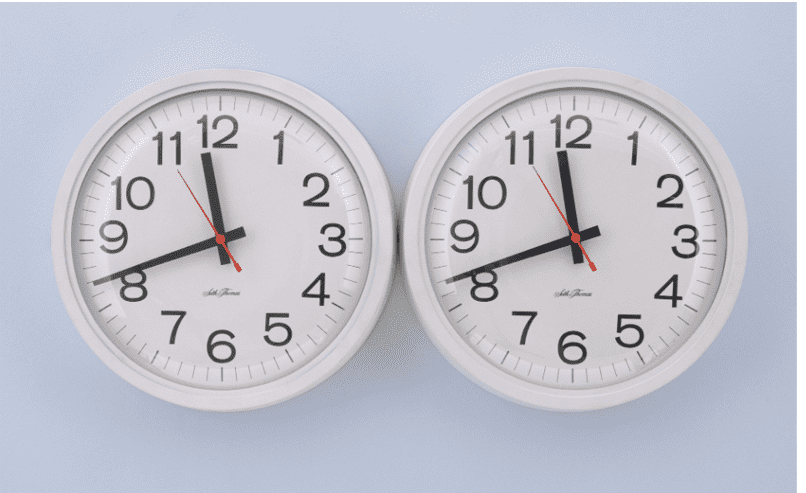
I had two in-laws. The first was a normal teacher, with a slightly backward view of the role of women in society, she taught girls housework at school. This was before the Revolution. But she worked things out in very unusual ways, she was always making things up. I was able to learn a lot from her. At one time, she was very committed to doing projects, she had been working intensely for months on end, losing weight. I dreamed of radical Italian design from the 1960s to 1970s, until one day she puts a broken fan on the table and starts trying to fix it. She didn’t say anything to me and I soon realized that what I was doing was rubbish. I realized that I was wrong to go on with those projects, because I wanted to have a sincere view of reality. From that, I started to pay attention to these types of practices [gambiarras] and to work together with my mother-in-law in these everyday solutions. I even started to understand this as a design practice. So I start recording these solutions, starting at my house, then at the neighbors, in Havana, and then I travel around the island in this search. Many of the objects and practices that I have registered are considered illegal under Cuban law, so people do not appear in the photos. I think about the production of these practices [gambiarras] in contexts other than Cuban, I don’t know how it is in Brazil, I wonder if, for example, university professors and doctors develop this type of practice, here we have many cases.
MF: I know that there is a question of access, of remuneration, and that we imagine that doctors and university professors, those already established, not emerging ones, tend to have better economic conditions. But, in addition, I notice some people who, in addition to having stability, still have the need to solve things and do them in unusual ways. I believe it is something that also acts on the plane of desire. This type of conduct I notice in the most varied gambiarras and situations that I observe and I have news. So, yes, it is evidently a matter of material, economic necessity, but I don’t think that ends with that. In favelas and in the most economically disadvantaged regions, it is clear that gambiarras will be more frequent. These processes of thinking beyond the standards (of brand, design, beauty, market, use, function, and so many others linked to the status quo) tend to be more intense in places understood as less central, in general. This type of thinking is part of what I have been researching[5], the idea that ways of thinking, such as those that produce gambiarras, are also diluted out there. They are everywhere where hegemonic thinking is absent, which is frequent in societies with a western tradition.
Returning to the work “Technological Disobedience”, in the text of the exhibition catalog [OROZA, 2015], there is a term “imaginative leap”, could you comment a little on this idea?
O: I believe that the idea of “imaginative jumping” has its own leaps and appearances within the text “Technological Disobedience” [OROZA, 2015], which has already been published in different ways. There are introductory blocks that are not present in all publications.
This idea is a kind of counterproposal to a job I was doing with a team of French people who wanted to talk about the flows in cuban houses, but from a perspective that seemed quite wrong and from which, therefore, I dismayed myself.
“Imaginative leap” has to do with a broader conversation with industrial culture. A critique of the new, the perfect, linked to design ideas related to the Ulm school in Germany, directed by Max Bill, about the paradigm of maximum beauty and perfect object.
In these leaps, it’s not just about creating something new: it’s something that brings with it some new relationship. New social relations emerge when Che Guevara summons: trabajador, construye tu propia maquinaria. These objects, which I first called “discrete objects”, “sensitive objects”, have the potential to change the way they consume, not just material culture. These modifications, by blurring these patterns, are also a political achievement, a leap in functionality.
I prefer to think that in one way there are many other possibilities of relationship including – for designers, but not just for these – and that from openings to modifications there is an invitation to the other. Of course, these possibilities of reuse and reparation have always existed. But in this period there is an intensification, including the sharing of this knowledge about technical objects. The objects that broke were opened to be repaired, and with that closed systems become open, systems that could seem impenetrable. Thus, the objects began to be disassembled, repaired, and, at a later time, reinvented in the houses. This knowledge was being shared among people, practices that go against the consumerist logic of capitalism. I get inspired by Augusto Boal, who said that everyone can do theater, including actors, to think that everyone can do project, including designers.
MF: Do you know the Brazilian jericos[6]? They have some points of proximity to the Cuban rikimbili[7]. It is a usual practice, especially in southern Brazil: vehicles in general built with parts from other vehicles, to work in rural properties. But festivals and races of this mode of “gambiarra vehicle” are also made.
O: Interesting. It is also interesting to note how regulation can affect the landscape. In Cuba, there was a law that allowed cars to be changed only by 40%. That limit later rose to 60%. This leads to significant changes, which at the same time are very difficult to quantify. I remembered the trucks in Cuba that we call cara de palo [cara de pau in Portuguese] and with that came the work of Hélio Oiticica, due to Cara de Cavalo (figure associated with the crime and reference present in some works of artist, as in the poem-flag “Be marginal. Be a Hero”). It is possible to make associations about the idea of the marginal, to be on the margins of certain standards.
MF: Are you currently developing a project?
O: I have thought about the musical practice of suddenly with technological disobedience. I’m working on a movie that talks about it. The same practice, in different places, as it comes to develop in different ways. I center on two cities: in Hileah, Miami, USA, and Pinar del Río in Cuba. For repentistas to work their improvisations I suggest words that are usually foreign to the usual repertoire. I then reflect on the sudden in different places, and about the relationships of the repentistas with the metric. I’m interested in rhythm-related issues in the practices of Technological Disobedience and all of a sudden. This also has to do with gypsy, Andalusian, African culture, which relate to cultural processes in Cuba, Mexico, Brazil, for example.
MF: Yes, issues also related to studies on misceage. It has some points in common with the research we developed in the Communication and Culture Research Group: Baroque, Oralities and Mestism[8]. In between, we studied a lot of Cuban authors such as Severo Sarduy and Lezama Lima.
O: Yes, they are key authors for me. Like Sarduy’s idea of retombée. And also [the poet Luis de] Góngora, Lezama’s intellectual father. I like a poem in which he works on the Latin translation of the phrase necessitats caret lege, translated into Spanish as la necesidad tiene cara de hereje, but that could have been something like la necesidad carece de ley.[9] The need has been stigmatized by Western culture: if you say you have a need, you are seen as weak. But understanding that you need something can be a moment of freedom, in the sense brought by Espinosa, Hegel, Engels …
REFERENCES
CAMPOS, Haroldo de. Transcriação. Org. Marcelo Tápia e Thelma Médici. São Paulo: Perspectiva, 2015.
JORNAL MARCO ZERO. Brasília Teimosa, periferia de Havana, 2015. Disponível em: << https://marcozero.org/brasilia-teimosa-periferia-de-havana/. Acesso em: nov., 2020.
OROZA, Ernesto. Desobediência Tecnológica. Disponível em: <http://www.desobedienciatecnologica.net/>. Acesso em: fev. 2019.
____________________. Rikimbili. Disponível em: << https://www.ernestooroza.com/rikimbili/>. Acesso em: nov., 2020.
____________________. Desobediência tecnológica. Catálogo da exposição Caixa Cultural de Recife, 2015. Disponível em: <<http://museo.com.br/catalogodesobedienciatecnologica.pdf>. Acesso em: fev. 2019.
GONZALES-TORRES, Félix, Untilted, (perfect lovers), in: Tempo. Catálogo da exposição. HERKENHOFF, Paulo et al. MOMA, Nova York, 2002.
__________________________. Untilted, (perfect lovers), 1991. Disponível em: <<https://www.moma.org/collection/works/81074 >. Acesso em: jun. 2020.
MELLO LOPES, Maria Fernanda de. Gambiarra como processo: uma antropofagia latino-americana. Dissertação de Mestrado apresentada no departamento de Comunicação e Semiótica da PUC-SP. São Paulo, 2019. Disponível em: << https://tede2.pucsp.br/handle/handle/22878> Acesso em nov. 2020.
APPENDIX – FOOTNOTE REFERENCES
3. El paquete semanal or just el paquete is a compilation of digital material of about a terabyte, marketed in Cuba in the informal market through external HD’s. Because of the high cost and difficulties of the Cuban population to access the internet, part of the content, usually linked to entertainment, which could be accessed through the Internet, is through these compilations. As in the case of cartoons, series, movies, among other types of audiovisual content. These HD’s are updated weekly by those who work with their distribution.
4. Article “Brasília Teimosa, periferia de Havana”, published in 2015. Available in: https://marcozero.org/brasilia-teimosa-periferia-de-havana/
5. For more information on this: see ‘Gambiarra as a process: a Latin American anthropophagy’ (LOPES, 2019)
6. You can see a recording of uprip, race, of jericos in: https://www.youtube.com/watch?v=a91GYiudSRk
7. Rikimbili is the name used in Cuba to refer to bicycles that are handcrafted modified, becoming fuel-powered bicycles, among a number of other changes, adaptations and repairs. More information can be found in Ernesto Oroza’s blog post, available at: https://www.ernestooroza.com/rikimbili/ as well as in some of the figures contained in the Catalogue of the Technological Disobedience Exhibition (2015, p, 48 – 49).
8. Research group linked to the Graduate Program in Communication and Semiotics of PUC-SP, led by Prof. Dr. Amálio Pinheiro.
9. Oroza develops this idea on his blog. For more information see =: http://www.ernestooroza.com/la-necesidad-tiene-cara-de-hereje/
[1] PhD student and Master in Communication and Semiotics by the Pontifical Catholic University of São Paulo (PUC-SP), Master by the Independent Studies Program (PEI) at the Museum of Contemporary Art in Barcelona (MACBA), linked to the Autonomous University of Barcelona (UAB). Member of the Research Group Communication Baroque Culture and Mestizo in PUC-SP.
[2] Advisor. PhD in Communication and Semiotics. Master’s degree in Literature. Specialization in Hispanic-American Literature. Law degree.
Submitted: November, 2020.
Approved: November, 2020.

